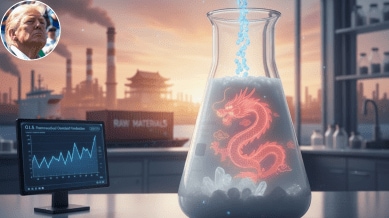Stay updated with the latest - Click here to follow us on Instagram
Despite Trump’s tariff war, US cannot afford to let go of business with China. Here’s why
Nearly 700 U.S. medicines use at least one chemical solely sourced from China. Experts say there is no financial incentive for the production of raw materials in the United States.

For years, Democrats and Republicans have sounded the alarm about America’s dependence on China for medicines. An analysis published Wednesday shows just how deep that reliance is at the earliest stage of the drug manufacturing process: Nearly 700 U.S. medicines use at least one chemical solely sourced from China.
As tensions between Washington and Beijing have escalated in recent years, experts fear that this reliance could leave American patients vulnerable, especially if a trade war or future pandemic prompts China to curtail exports. Supply shortages for some generic medicines have already grown common.
monthly limit of free stories.
with an Express account.
The new data, from U.S. Pharmacopeia, a nonprofit that tracks the drug supply, identified the origins of chemicals used to make medicines. The analysis found that China was the sole supplier of at least one chemical in widely used antibiotics, such as amoxicillin, and generic drugs for heart problems, seizures, cancer and HIV.
One example is the allergy-relief medicine best known by the brand name Benadryl. (Kenvue, the company that sells Benadryl, did not return a request for comment.)
There is almost no production of these chemicals in the United States because making them is dirty and labor and other costs make manufacturing them unprofitable. Chinese factories, by contrast, don’t face the same environmental restrictions and can make these raw materials inexpensively.
President Donald Trump last week said he would impose a 100% tariff on all products from China to retaliate for curbs Beijing announced on rare-earth minerals. If he follows through, it could potentially mean that at least some drugmakers would pay hefty levies on raw materials that they import from China to make their products.
Trump has threatened to impose tariffs of up to 15% on brand-name drugs from the European Union and 100% from other parts of the world, but he has delayed those. Most major drugmakers have said they will be exempt from any future drug tariffs, because of new U.S. manufacturing investments or drug pricing deals they have negotiated with the administration. The Trump administration has no plans to impose tariffs on generic drugs, an administration official said.
This year, with Trump threatening tariffs, nearly all of the largest brand-name drugmakers have announced plans to spend billions of dollars building or expanding U.S. factories. But these plants will not make raw materials. Instead, they are expected to handle the later stages of drug production for top-selling medicines.
Experts who study the drug supply chain said there was no financial incentive for the production of raw materials to return to the United States.
Making medicines is a multistep process, with factories in different countries often handling different stages. The process starts with the production of raw materials. A factory, often in India, will import those raw materials and use them to produce active ingredients, which will then be used to formulate the drug.
U.S. Pharmacopeia’s analysis showed that even medicines that appeared to have broad geographic production can be reliant on China.
Take, for example, amoxicillin, the widely used antibiotic that is sold by many different generic manufacturers. Factories in different parts of the world, including India, Jordan and Canada, handle the later stages of producing it. But two of the raw materials used to make amoxicillin are produced entirely in China, the analysis found.
“Our hope is that by having better data and more visibility, that can inform targeted interventions into creating resilience and security for patients,” Carrie Harney, an official at U.S. Pharmacopeia, said.
This article originally appeared in The New York Times.